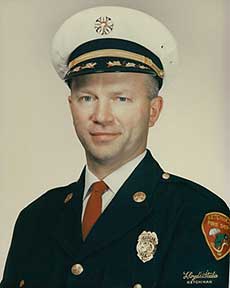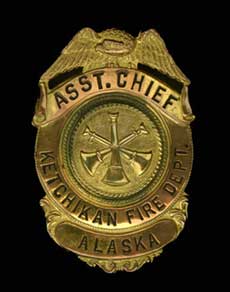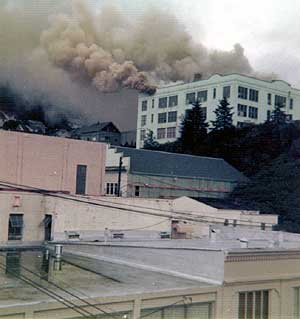 Buckets to hydrants to hi-tech By June Allen January 15, 2004
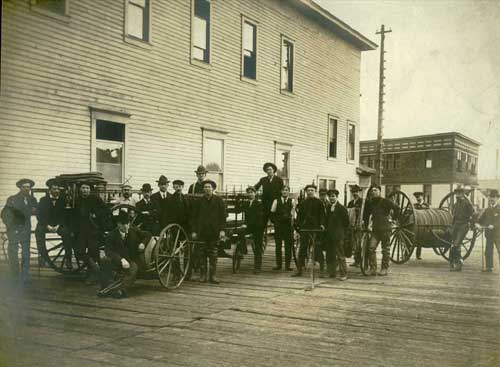 Photographer: Harriet Hunt Donor: Bertha Hunt Wells, Courtesy Tongass Historical Society In brand new 1900 Ketchikan, the fear of fire must have been strong! The business sections of the little town that hugs the shoreline of Tongass Narrows was built largely on wooden piling, with docks stretching out over tideland to reach deep water for the busy maritime traffic of Alaska's Inside Passage. Both downtown and Newtown plank streets rested on piling, and wooden "stairway-streets" climbed steep hillsides to blossoming residential neighborhoods also built of wood. In those founding years buildings were lighted with coal oil lamps and heated with wood-and-coal stoves with chimneys that belched and sparked embers into the southeast winds. In spite of the abundant rainfall, a few days of dry weather could turn the town and the investments of its people to tinder. Ketchikan needed fire fighting capability before almost anything else. That came a few weeks before Ketchikan's late August incorporation. D. Smith Harris organized a bucket brigade of volunteers in June of 1900, an organization that required members simply to own a bucket and be able to carry it full of water. Ketchikan has never lacked for water - salt water, creek water, rain water. Residents were alerted to keep rain barrels full of water for fire emergencies. And the town never lacked for volunteers then, or now, dedicated to preventing and fighting fires. Everyone in 1900 was a newcomer, everyone willing to participate in order to share a rosy future.  The ship caught fire September 22, 1945. She was towed from the dock and allowed to burn when it became clear that the fire was uncontrollable. Donor: Bert Libe, Courtesy Tongass Historical Society
Ketchikan was growing rapidly. The brand new school on Main Street (later remodeled into a Catholic Church and only recently torn down for a parking lot) was welcoming a larger student body each month. Rapid city growth was running ahead of the growing municipality's ability to pay for necessary services, but expansion continued anyway. Downtown and Newtown were soon connected with a 10-foot-wide walkway, doubling the town's size. New people were arriving on every ship, properties traded, and new homes going up. And while more taxes were being collected the mill rate was at 7.5 mills - education and increased enrollment at the new schoolhouse on Main Street ate up most of the tax dollars. 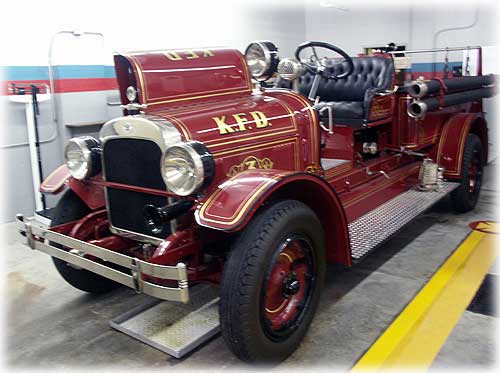 Photo by Dick Kauffman
The new fire house was ready for business and a proud dedication on New Years Day 1904. It was a utilitarian two-story wooden building, with the second floor intended for city council chamber use. Council members ceremonially met there on a cold and windy day three days after the dedication and never used the space again, preferring to meet elsewhere in less Spartan surroundings. The upstairs space was used instead as a gymnasium for firefighters, a compromise that probably satisfied both civic bodies. Within ten years the firehouse was labeled "City Hall" on a 1914 fire map and may have served other centralized civic needs. The firehouse also made room for a tiny jail tucked into a back corner. 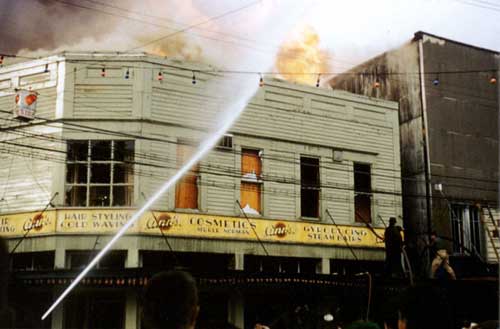 Color snapshot of the fire which destroyed Red Men's Lodge on the corner of Mission and Main Streets. Donor:Evelyn, Valentine, Courtesy Tongass Historical Society
Shortly after the opening of the Ketchikan firehouse, the city chose popular and prudent councilman John Stedman, builder of the almost-finished Stedman Hotel, to oversee the purchase of a fire bell and other necessities for the firehouse. He directed Fire Warden Fremont King the buy the Halloway Chemical Engine No. 73, plus two extension ladders and 100 more feet of hose. The chemical engine provided a source of water under pressure for fighting small fires. It was a source of great pride in the department and was used occasionally until 1923 - and is now stored in the West End fire station. The engine had two 35-gallon copper tanks filled with soda water. It was hand-pulled with handles designed for two men. But an early resident and volunteer fireman, Ralph A. Bartholomew, father of former Fire Chief and mayor Ralph M. Bartholomew, fondly remembered those early days when that heavy, lumbering engine was pulled by just one husky volunteer who made it clear he could handle it alone and performed that feat at every fire for years. It was also way back 1904-1905 when a "modern" electric fire alarm system was installed. In a town without telephones at the time, the four original street alarm boxes were critical to fire protection. Later, ten more boxes would be added. That first alarm system was very up-to-date in 1904! When the alarm box was activated, an electric signal was sent by wire directly into the fire station, where a ticker tape was punched with the location of the street box. Over the years other alarm systems were installed, one by radio waves and another via the firehouse whistle. That's the one nostalgically remembered by today's oldtimers. Fire locations were announced to the city by the fire whistle via long and short blasts. Firemen had the code blasts memorized. Residents could grab their KPU phone books an find the locations of the various signals inside the front cover. The biggest fire department news of the second decade of the century was the purchase in 1914 of a Model T fire truck. It was placed in service as Truck 1. Chief Harvey Stackpole was authorized to buy it at a cost of $ 468.51 - that would be $7,930.47 in today's dollars. It was a source of enormous pride to the city fathers and to the firemen! And every little boy in town wanted to grow up to be a fireman and drive that truck! The status and cachet of being a Ketchikan volunteer fireman was keen in those days. Over the years the city purchased more equipment for the department. Lawrence Kubley, popular baseball star and businessman during the first half of the 20th century, was fire chief in 1925 when the city authorized the purchase of an American LaFrance pumper and a Seagrave pumper. They were designated Trucks 2 and 3. Truck 3 is now housed today in the West End station and affectionately called "Grandma" today. All these years later, "Grandma" is still driven in Fourth of July parades to celebrate those early days. The varieties of the fires ranged from Independence firecrackers landing on shingled roofs to plank streets catching fire to hotels going up in flames to boats belching smoke and flame in the harbor. Ketchikan's volunteer firefighters tamed those fires, some seemingly too large for such a small town, and commanded the entire community's deep gratitude and respect for their service. By the early 1940s a new fire station was badly needed. Plans had been under way for a new firehouse before the entry of the nation into World War II. The war only intensified the need for the strongest possible fire protection! Ketchikan, under blackout status after the Dec. 7, 1941 sneak attack on Pearl Harbor, feared the very real hazard of incendiary bombs launched from enemy submarines known to be in nearby Alaska's waters. Both the British Columbia and Oregon coasts had been hit by enemy incendiaries. Ketchikan's volunteer firemen had their work cut out for them, placing barrels of sand for incendiary fire suppression on flat roofs and other critical locations. They assisted in
The 1943 fire station located near the Main and Dock Street intersection was concrete and built without a tower. But Main climbs at an angle up to Grant Street, ample slope to drain hoses. Until 1976, when the new West End station was built, hoses were laid along the gutter edge of Main street to drain. Longtime residents remember that process as well as the department's arrangement to get a work-release helper or two from jail to pull the heavy hoses uphill for draining. The second half of the century opened with significant changes for the nation and for Ketchikan's fire department. After World War II everything seemed to speed up, technological advances tumbled over one another and the nature of equipment, industry and labor changed. The town's fire department remained strong in spite of societal changes and Ketchikan's insurance rates reflected the excellence of their firefighters. They faced a decade of arson, often a sexual deviation crime that was little understood in the 1960s but was actually advanced nationally in the study of Ketchikan's arson fires. By the early 1960s Ketchikan's fire department had only one city employee in the fire department, the rest comprised of volunteers. Today there is a full complement of city employee firefighters assisted by a contingent of volunteers carrying on the same tradition of excellence begun by their forefathers. The pride of the volunteer tradition is evidenced by the fact that at the deaths of those oldtime volunteers, their badges are donated to the Tongass Historical Society. The numbers on those badges record a list of the founding fathers of a proud community.
P.S. It would take an entire book to record the entire history of Ketchikan's Fire Department. June Allen
june@sitnews.org
All rights reserved. Not to be reprinted in any form without the written permission of June Allen.
|
|||||||||
